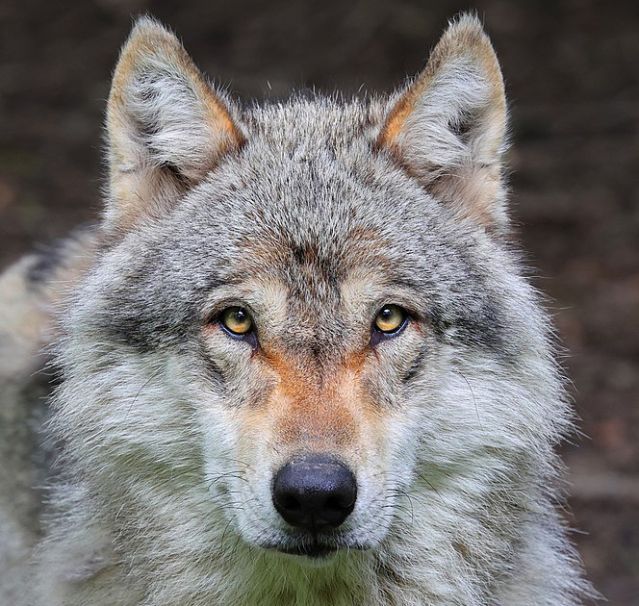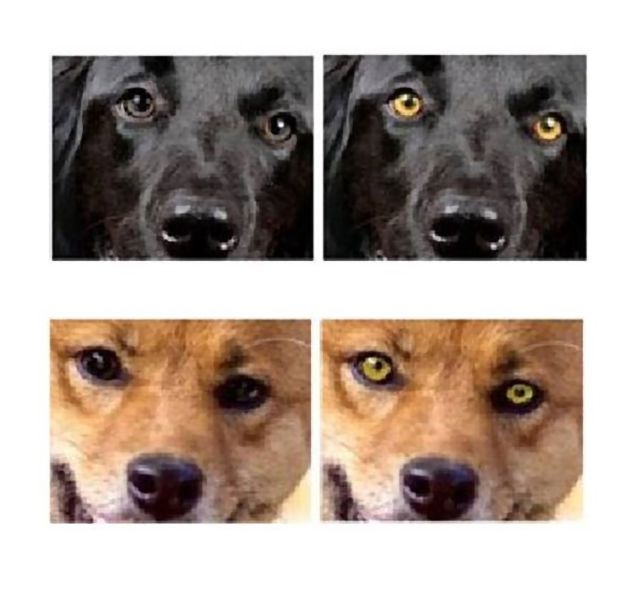Evolutionary Psychology
Why Do Most Dogs Have Brown Eyes While Wolves Do Not?
Domestication has driven the difference in iris color between dogs and wolves.
Posted April 17, 2024 Reviewed by Lybi Ma
Key points
- Most wolves have light, often yellow-colored eyes, while most dogs have brown eyes.
- Human observers tend to rate dogs with darker eyes as friendlier and more puppy-like.
- During domestication people may have selected for brown-eyed dogs because they appear more companionable.

American author and humorist John Kendrick Bangs wrote:
"I have no dog, but it must be / Somewhere there's one belongs to me. / A little chap with wagging tail, / And dark brown eyes that never quail, / But look you through, and through, and through, / With love unspeakable and true."
Here we have an affectionate poem dedicated to a brown-eyed dog. Why do we almost never encounter loving odes about blue or yellow-eyed dogs? One obvious reason is that most domestic dogs have brown eyes. A quick scan through the breed standards from the American Kennel Club finds that only around 8 percent of dog breeds have any eye color that is acceptable other than brown. Why is that an interesting observation?
They Once Were Wolves
You probably do know that, as far as we can tell, most dog breeds were domesticated from wolves. Look at the eyes of wolves and what do you see staring back at you? In most instances, you will see a pair of yellow eyes. But Lassie, or Fido, your own personal domesticated wolves look back at you with deep reddish brown eyes.

In a recent research report Konno Akitsugu of the Department of Animal Sciences, Teikyo University in Japan led a team of investigators asking the same question, "Why do dogs mostly have brown eyes while their wild progenitors do not?" Of course, the first question that they had to answer was whether the casual observation that wolves generally have lighter-colored eyes than dogs was actually true. They collected samples of facial images of gray wolves and domestic dogs and measured the coloration of their eyes. Statistically, they confirmed that, as a rule, the iris color of dogs is overwhelmingly more likely to be darker and more reddish than that of wolves.
A Case of Human Intervention?
Ethologists, and others who study wolves, have suggested that the light-colored irises of wolves are adaptive. They may be useful for communication in the wild. Lighter irises make the pupils more visible. Since wolves are cooperative hunters this allows other members of the pack to get the message as to exactly what another wolf is looking at, and the size of the pupil indicates the animal's state of arousal. Why were the light-colored irises of the wolf lost following domestication?
This research team suggests that humans may have deliberately bred dogs to have darker, rather than lighter, eyes simply because it makes dogs look like better companions. Basically, this is an extrapolation from the fact that human babies have larger pupils than adults (and nearly everyone feels affection for babies), and dilated pupils are often associated with friendliness. Darker irises make the margin between the edge of the pupil less distinct so that in dogs the whole eye seems to be one big pupil. These investigators reasoned that if such considerations were true, then to a human observer, dogs with darker brown eyes should appear to have a different, more desirable, personality than dogs with lighter eyes.
Do Brown-Eyed Dogs Have a More Soulful Look?
To test this hypothesis the investigators gathered photos from different types of dogs, both pure and mixed breeds, with a range of different coat colors. To minimize the effects of head shape and other factors, they cropped each image so that what remained visible were both eyes pointing forward and the dog's muzzle. They used pairs of images leaving one with eyes in their natural color, while in the other image, the eyes were lightened to look more wolf-like, as seen here in two pairs of examples.

In two studies, 142 Japanese volunteers, mainly students, were asked to rate each dog on a set of personality traits that included friendliness, aggressiveness, intelligence, and maturity (this latter was really a composite of how puppy-like the dog appeared to be).
The results across the two studies were quite consistent. The data showed that the facial images of dark-eyed dogs were perceived as more friendly and puppy-like than those of the light-eyed dogs. Furthermore, the observers expressed a greater desire to interact with the dark-eyed dogs. The simple conclusion was that dark eyes on a dog tend to send a non-threatening and more inviting gaze signal to human beings. Those soulful brown eyes might stir some, people to write poems about their dogs.
The guess is that during the domestication process, human beings, using seat-of-the-pants applied genetics, gradually selected dogs with dark eyes because they looked as if they would be friendlier and more desirable as companions. Apparently, no one wants to wake up in the middle of the night to find that their pet dog is staring at them with the yellow eyes of a predatory wolf.
Copyright SC Psychological Enterprises Ltd. May not be reprinted or reposted without permission
References
Konno, A., Aoki, H., Suzuki, E., Furuta, S., Ueda, S. (2023). Are dark-eyed dogs favoured by humans? Domestication as a potential driver of iris colour difference between dogs and wolves. Royal Society Open Science,10230854. http://doi.org/10.1098/rsos.230854


